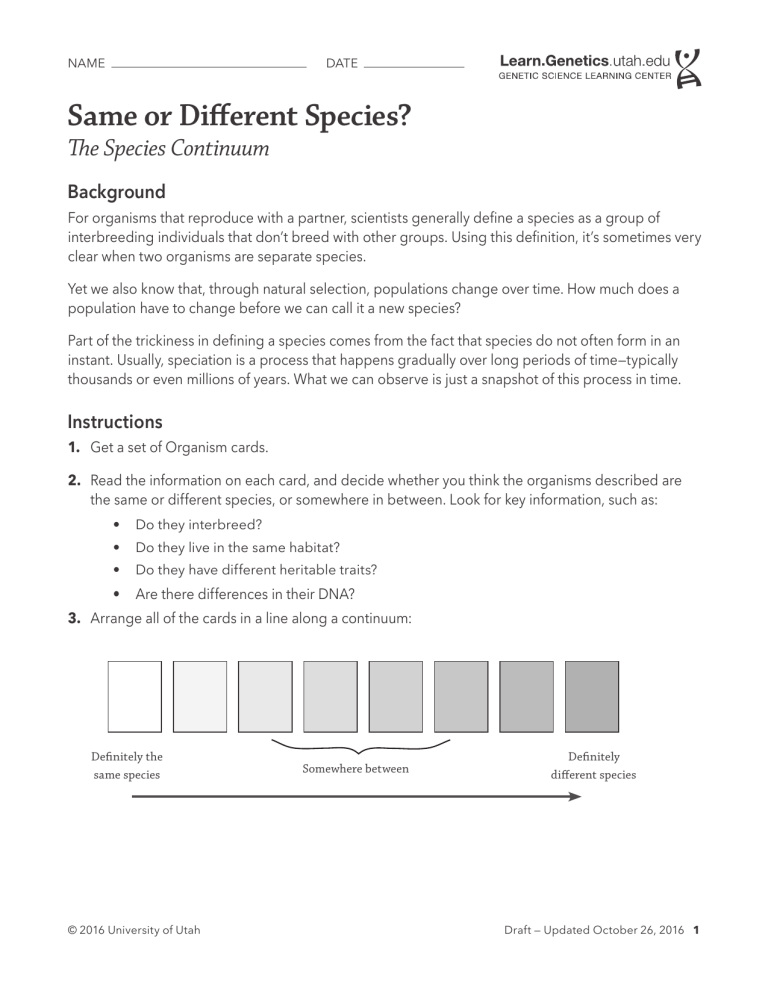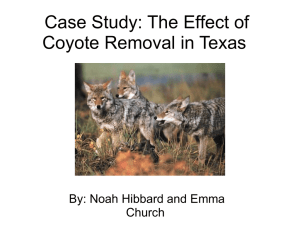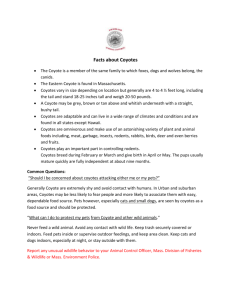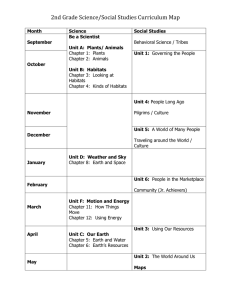
NAME DATE Same or Different Species? The Species Continuum Background For organisms that reproduce with a partner, scientists generally define a species as a group of interbreeding individuals that don’t breed with other groups. Using this definition, it’s sometimes very clear when two organisms are separate species. Yet we also know that, through natural selection, populations change over time. How much does a population have to change before we can call it a new species? Part of the trickiness in defining a species comes from the fact that species do not often form in an instant. Usually, speciation is a process that happens gradually over long periods of time—typically thousands or even millions of years. What we can observe is just a snapshot of this process in time. Instructions 1. Get a set of Organism cards. 2. Read the information on each card, and decide whether you think the organisms described are the same or different species, or somewhere in between. Look for key information, such as: • Do they interbreed? • Do they live in the same habitat? • Do they have different heritable traits? • Are there differences in their DNA? 3. Arrange all of the cards in a line along a continuum: Definitely the same species © 2016 University of Utah Somewhere between Definitely different species Draft — Updated October 26, 2016 1 Salmon & Goldfish Grizzly Bears & Polar Bears Since salmon and goldfish are both fish, they have many traits in common. But they have many differences too. They live in different habitats, they eat different food, they behave differently, they have very different anatomy—and they never interbreed. A large body of evidence shows that they descended from a common ancestor, yet at some point in the distant past, maybe their ancestors weren’t so different from one another. Grizzly bears live in diverse habitats in the norther hemisphere, where they eat a wide array of fruit, plants, and meat. Polar bears live in frozen lands to the north, where they roam on ice sheets and hunt seals. The two bears have different anatomy and behavior, and they are broadly considered to be different species. DNA analysis estimates that they diverged from a common ancestor about 400,000 years ago. Yet once in awhile, at the edges of their ranges, they do meet and interbreed. Using genetic testing, researchers have identified multiple “grolar bear” hybrids in the wild. Fly Agaric Mushrooms Common & Australian Blacktip Sharks These poisonous mushrooms live in many places around the world. Different populations have different characteristics. Most are red with white spots, but others are yellow, orange, white, tan, or brown. Fly agaric mushrooms reproduce using spores, which can travel by wind across great distances. Because they are isolated, with little chance of interbreeding, populations living on different continents have traditionally been considered different species. Yet DNA analysis has shown that even populations living in North America form genetically distinct groups. Each group occupies a distinct habitat, and alleles do not mix freely between them. The common blacktip shark lives in coastal waters around the world. The Australian blacktip shark, which lives off the coast of northern and eastern Australia, looks almost identical to the common blacktip—though it is smaller, it lives in warmer water, it has a different number of vertebrae, and it has unique genetic markers. The two types of sharks were once thought to reproduce only with their own kind. However, using genetic markers, scientists have found dozens of sharks off the coast of Australia that are hybrids between common and Australian blacktips. Yellow and Olive Baboons Western & Eastern Coyotes These two types of baboons live in Africa. Because they live in mostly separate areas, and they have clear differences in social structures, anatomy, and mating behavior, they are considered to be different species. Yet in an area in Kenya, they share a habitat. Where they meet, they interbreed, forming a “hybrid zone.” For the most part, alleles from the olive population are making their way into the yellow zone, not vice versa. Genetic analysis suggests that this hybridization has been going on for a long time, and that the olive population is slowly extending into the habitat of the yellow population. Coyotes are a wild species related to wolves and dogs. Before about 1900, coyotes lived only in western North America. As they gradually expanded eastward, the first wave of coyotes met—and bred with—wolves, and later dogs, possibly because there weren’t many coyote mates to be found. Today the descendants of these animals, known as eastern coyotes, live all over eastern North America, and they mate with other coyotes rather than dogs or wolves. Yet they carry significant numbers of wolf and dog alleles, which probably contribute to their larger size, diverse coat colors, facial features, and other highly varied traits. Eurasian Blackcaps A large group of these songbirds spend their summers in Germany, where they mate and raise their young, and their winters in Spain. Within the last 60 or so years, a subgroup has started overwintering in Britain. It turns out that migration direction is genetically programmed, so their offspring go to Britain too. Because they have a shorter flight, the British overwintering population tends to arrive in Germany earlier, where they pair up and mate with each other. This subpopulation is starting to look different, and DNA testing can accurately determine where a bird overwintered about 85% of the time. Dark & Light Rock Pocket Mice In the Southwestern United States, populations of rock pocket mice live in dry, rocky habitats. Some rock pocket mouse habitats contain a mixture of light-colored rocks interwoven with dark black lava flows. If you set out traps on the light-colored rocks, you’ll catch mostly light-colored mice. On dark lava, you’ll catch dark-colored mice. Yet the mice show no preference for mates of either color, and they freely interbreed.




